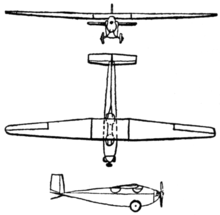Messerschmitt M17
| Messerschmitt M 17 | |
|---|---|

|
|
| Type: | Light aircraft |
| Design country: | |
| Manufacturer: | |
| First flight: |
January 1925 |
| Number of pieces: |
7 + 1 replica |
The M 17 was the first powered aircraft that Willy Messerschmitt built in Bamberg in 1925. The two-seater, made almost entirely of wood, weighed only 198 kilograms.

history
The first M 17 "Ello" to be built took first place in the high-altitude flight and speed difference flight competition and second place in the cross-country flight competition at the Oberfrankenflug from May 2 to 4, 1925 with Heinrich Seywald on board. This machine crashed a little later on May 14, 1925 in Bamberg and was totally destroyed in the process. Seywald and Willy Messerschmitt, who was also flying, were only slightly injured. At the Schleissheim “International Flight Competition” from September 12th to 14th, 1925, Carl Croneiß won first prize in both high and speed flight with an M 17. From September 20 to 29, 1926, the pilot Eberhard von Conta and the writer Werner von Langsdorff flew in an M 17 (D-887) from Bamberg to Rome . They crossed the Central Alps for the first time in a light aircraft . The two had to interrupt the 14-hour and 20-minute flight on the 1620-kilometer route every three hours to refuel because the tank only held 28 liters. The flight altitude was partially 4500 meters.
Received aircraft
Of the six to eight machines built, only one has survived in its original form; it is in the Deutsches Museum in Munich.
A replica (D-ERTA) was shown at the International Aerospace Exhibition in Berlin , which was built by Bitz Flugzeugbau on behalf of the Messerschmitt Foundation . However, this aircraft weighs 40 kg more than the original due to the additional devices installed ( e.g. radio and rescue system ). The M 17 will later come to the Flying Museum in Manching near Ingolstadt .
Technical specifications
| Parameter | Data |
|---|---|
| crew | 1 |
| Passengers | 1 |
| length | 5.85 m |
| span | 11.60 m |
| height | 1.50 m |
| Wing area | 10.40 m² |
| Wing loading | 35.6 kg / m² |
| Empty mass | 186 kg |
| Payload | 184 kg |
| Max. Takeoff mass | 370 kg |
| Cruising speed | 125 km / h |
| Top speed | 140 km / h |
| Rise time | 12.5 min at an altitude of 1000 m |
| Service ceiling | 4000 m |
| Range | 600 km |
| Engine | a Bristol Cherub with 22 kW (30 PS) or an ABC Scorpion with 17.6 kW (24 PS) |
See also
Web links
- Contemporary illustrations, technical data and history of seven machines (English)
- Messerschmitt M 17, official website of EADS
Individual evidence
- ^ A b Hans J. Ebert, Johann B. Kaiser, Klaus Peters: Willy Messerschmitt - pioneer of aviation and lightweight construction. In: German aviation. Volume 17, Bernard & Graefe, Bonn 1992, ISBN 3-7637-6103-9 , p. 43.
- ↑ FliegerRevue August 2010, pp. 56–59, Messerschmitt rises
- ^ Deutsches Museum: Messerschmitt M 17


